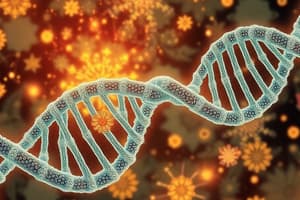Podcast
Questions and Answers
How many nitrogenous bases are there?
How many nitrogenous bases are there?
four
G stands for?
G stands for?
Guanine
A stands for?
A stands for?
Adenine
T stands for?
T stands for?
C stands for?
C stands for?
What base pairs with Cytosine in DNA?
What base pairs with Cytosine in DNA?
What base pairs with Thymine in DNA?
What base pairs with Thymine in DNA?
What nucleotide hydrogen bonds with Adenine in DNA?
What nucleotide hydrogen bonds with Adenine in DNA?
What base pairs with Guanine in DNA?
What base pairs with Guanine in DNA?
How can nitrogenous bases be categorized?
How can nitrogenous bases be categorized?
Which two bases have a single ring structure?
Which two bases have a single ring structure?
Which two bases have a double ring structure?
Which two bases have a double ring structure?
What are the pyrimidine bases?
What are the pyrimidine bases?
What are the purine bases?
What are the purine bases?
What is complementary base pairing?
What is complementary base pairing?
What are base pairs?
What are base pairs?
What forms a strand of DNA?
What forms a strand of DNA?
What does it mean that DNA strands are antiparallel?
What does it mean that DNA strands are antiparallel?
For hydrogen bonding to work, DNA strands must run in what direction?
For hydrogen bonding to work, DNA strands must run in what direction?
What is the 5' end of a DNA strand?
What is the 5' end of a DNA strand?
What is the 3' end of a DNA strand?
What is the 3' end of a DNA strand?
Why do DNA strands need to be antiparallel?
Why do DNA strands need to be antiparallel?
Which of the following statements is true?
Which of the following statements is true?
Which bases are categorized as purines?
Which bases are categorized as purines?
The sugar end of the DNA strand is referred to as the _____ end and the phosphate end is referred to as the _____ end.
The sugar end of the DNA strand is referred to as the _____ end and the phosphate end is referred to as the _____ end.
Adenine forms ___ hydrogen bonds with Thymine.
Adenine forms ___ hydrogen bonds with Thymine.
Cytosine forms ___ hydrogen bonds with Guanine.
Cytosine forms ___ hydrogen bonds with Guanine.
Flashcards are hidden until you start studying
Study Notes
Nitrogenous Bases Overview
- Four nitrogenous bases are present in DNA: Adenine, Guanine, Cytosine, and Thymine.
- Each base is critical for forming the genetic code.
Base Pairing
- Guanine pairs with Cytosine through three hydrogen bonds.
- Adenine pairs with Thymine through two hydrogen bonds.
- Complementary base pairing is essential for the DNA structure.
Base Classification
- DNA bases are categorized into two groups:
- Purines: Adenine and Guanine (double-ring structure).
- Pyrimidines: Cytosine and Thymine (single-ring structure).
DNA Structure
- DNA strands consist of covalently linked nucleotides forming a linear sequence.
- Strands run in opposite directions, a configuration known as antiparallel.
- The sugar end of a DNA strand is called the 3' end, while the phosphate end is the 5' end.
Importance of Antiparallel Orientation
- Antiparallel orientation allows for effective hydrogen bonding between complementary bases.
- Proper pairing is crucial for DNA stability and replication.
Key Points on Hydrogen Bonding
- For hydrogen bonds to form, DNA strands must align in opposite directions.
- Adenine and Thymine bond via two hydrogen bonds, while Cytosine and Guanine bond via three hydrogen bonds.
Miscellaneous Facts
- The term "Base Pairs" refers to bonded nitrogenous bases within the DNA structure.
- Correct hydrogen bonding ensures accurate genetic information transfer during cellular processes like replication.
Studying That Suits You
Use AI to generate personalized quizzes and flashcards to suit your learning preferences.




